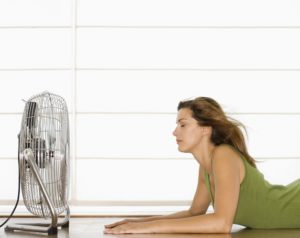One complaint sleepers may have about their bed is that they wake up hot, maybe even sweating. This can be extremely uncomfortable and disruptive to your sleep health. In some cases, this may be due to the sleep environment, bedding, or mattress. However, there are ways you can change your environment, sheets, and mattress to avoid sleeping hot. So what can you do to ensure a cool and comfortable night of sleep? Read on to discover your options.
Your Sleep Environment
The first solution to avoid sleeping hot is to keep your bedroom cooler. Experts recommend keeping your room temperature somewhere between 65 and 70 degrees Fahrenheit, but you can experiment to see what is most comfortable.
You can also use a fan to help keep your body temperature down and create airflow that pulls warm air through the mattress. Fans are also helpful for making white noise, which many sleepers find beneficial.
Your Bedding
There are three essential bedding components that can influence your sleep temperature.
Mattress Protector
If you use a mattress protector, make sure it is breathable. The cheaper, plastic-y protectors don’t breathe well and can keep a mattress warmer than it otherwise would be. If you suspect the protector is the reason for sleeping hot, remove it for a night or two to see how you feel.
Sheets
Some sheets are more breathable than others. For instance, flannel sheets are great for keeping you warm and insulated in the winter, but they will be too hot during the summer. Cotton sheets vary depending on what weave they use. If the threads are woven too tight or too thick, the air can’t easily flow.
Blanket, Comforter, or Duvet
Use the appropriate thickness of blanket, comforter, or duvet. You may prefer to use a thicker blanket as you sleep in a cold room. However, if you’re still sleeping hot, you may need to switch to a thinner blanket.
Your Mattress
Sometimes your mattress is the reason you are sleeping hot, in which case it may be best to find a new one that won’t cause you so much discomfort. When evaluating your mattress, consider the following.
Make Sure Your Mattress Has Airflow
Features like convoluted foam, holes in the foam, and ventilated sides can help airflow through the mattress, even pulling body heat through. Innerspring mattresses have more airflow than foam, but an innerspring with a thick foam top layer can still have issues.
Latex Foam Keeps a Neutral Temperature
Latex mattresses can still get warm, but they warm up more slowly than polyurethane foams like memory foam. Latex generally has small holes that run through it, which add more airflow. If you have a memory foam mattress that sleeps hot, consider adding a latex topper.
Phase Change Materials
Some mattresses have “phase change materials” designed to keep the mattress at a neutral temperature. Instead of warming up or cooling down, the material changes phase. Phase change materials can also be found in mattress protectors.
There are many reasons why you may be sleeping hot. However, you have many opportunities for adjusting your sleeping environment, bedding, and mattress to ensure that you sleep more comfortably in the future.
Sleep Well With A Mattress From All American Mattress
At All American Mattress, we have the expertise and great prices to help you choose the perfect pillows and foam mattress for your bedroom. We have mattresses and bed frames available made from a variety of materials to suit your needs, whatever they are. Stop by our showroom, visit us online, or give us a call at (410) 451-9006 to see how we can get your toddler sleeping through the night. We offer brand names at affordable prices, and we will always work hard to keep your whole family comfortable. For more mattress shopping tips, be sure to follow us on Facebook, Twitter, and Pinterest.
Tags: air flow, Mattress Tips, Sleep Tips, sleeping hot

